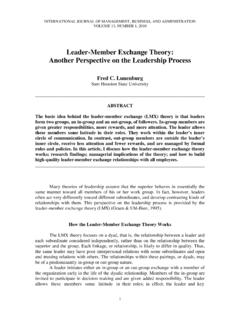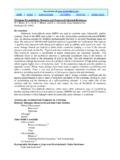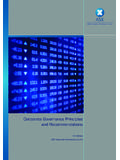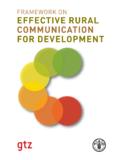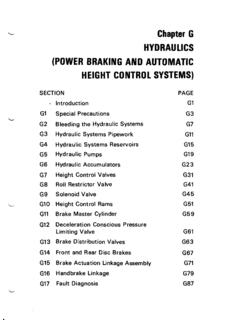Transcription of A Causal Linkage between FDI Inflows with Select ...
1 IOSR Journal of Economics and Finance (IOSR-JEF) e-ISSN: 2321-5933, p-ISSN: 5, Issue 5. ( 2014), PP 124-133 124 | Page A Causal Linkage between FDI Inflows with Select Macroeconomic Variables in India An Econometric Analysis 1 Gholam Syedain Khan, Papia Mitra2 1 Assistant Professor, Department of Commerce, St. Xavier s College (Autonomous), Kolkata 2 Junior Research Fellow, CUCSE-CEFM, Department of Commerce, University of Calcutta Abstract: The paper endeavour to explore the short run and long run Causal relationship between Select macroeconomic variables (GDP, Exchange Rate & Inflation Rate) and FDI Inflows in Indian context by applying Cointegration test followed by Vector autoregression (restricted/unrestricted) model and Granger-causality test.
2 Further, by employing simple regression model, it tries to calculate the exponential growth rate of FDI Inflows in India. Eventually, Chow test has been employed to detect the presence of significant structural break in the data series of FDI Inflows . However, the results show that there prevails long run equilibrium among the concerned variables. The Granger-causality test results conclude that exchange rate and GDP statistically significantly influence FDI, whereas, inflation rate is insignificant variable to predict FDI Inflows . Further, the growth analysis result claims that the total FDI Inflows grow exponentially at a rate of 23% per annum. However, as stated by the results of Chow test, 1991-92 (the year of initiation of New Economic Policy in India) is a statistically significant structural break year in the context of FDI Inflows in India.
3 Keywords: FDI, New economic policy, Unit root test, Cointegration test, Vector error correction model, Granger-causality test, Structural break, Chow test. I. Introduction Foreign direct investment (FDI) can be termed as package of resources that complements the financial flows and makes a distinctive contribution to the development process. Foreign direct investment projects typically involve a transfer of technology and managerial skills from the source country to the recipient country and also provide greater access to world market for the recipient country s exports. Foreign Direct Investment (FDI) is fund flow between the countries in the form of inflow or outflow by which one can able to gain some benefit from their investment whereas another can exploit the opportunity to enhance the productivity and find out better position through investment with the purpose of long term then it is contributes positively towards economy.
4 Depending on the industry sector and type of business, a foreign direct investment may be an attractive and viable option. The studies try to find out the implications which affect the economic scenario and also measure the level of predominance by the factors for economic contribution to India. Evaluation of India's FDI Policy Measures The liberal policy measures towards FDI designed in the wake of structural adjustment and macroeconomic reforms in India since mid 1991 have helped attract foreign investors significantly. The amount of approved investment has grown enormously. Though the actual inflow of FDI has not picked up so fast, it has improved and significantly strengthened the capital account of the balance of payments of the country. India is still on a lower ladder among some major FDI receiving countries of Asia.
5 Nevertheless, only six or seven countries claim well over one half of the total FDI flows. With the opening up of new areas for foreign investors, a huge amount of approval and actual inflow is also found in non-traditional areas, such as fuel and power, services and some consumer goods. Though the automatic approval route was introduced for speedier clearance of FDI proposals, its reach and role have been marginal. The policy lacked thrust on attracting investment in sectors that offered comparative cost advantage. Well-developed and strategically located platforms in the form of Export Processing Zones (EPZs) or technology parks have not been provided for mobilizing investment into these sectors. The thrust was not on export orientation due to conservative sector-specific policies. Rigid labour laws had been other serious impediments to FDI Inflows .
6 Besides, there was lack of transparency and clarity about micro-level procedure at the state level. To sum up, it can be said that the Indian Government has created a healthy atmosphere for FDI inflow by introducing Structural adjustment and Stabilization policy. A Causal Linkage between FDI Inflows with Select Macroeconomic Variables in 125 | Page Table I: Country-Wise Contributions of FDI Inflows in India (In US million dollars) The country-wise Inflows in FDI in India have been shown in the above table covering the period between 2007-08 and 2011-12. However, for most of the countries, the FDI Inflows had increased overtime. In the year 2007-08, Mauritius contributed maximum FDI Inflows in India followed by Singapore whereas the minimum FDI Inflows in India were from Luxembourg.
7 However, throughout the period of analysis, the main contributors of FDI Inflows were Mauritius, Singapore, USA, Japan, Netherlands & UK. However, the Inflows fell in percentage for Mauritius over the period. Mauritius and Germany accounted a negative percentage change in FDI Inflows in India. 2011-12 is the year of maximum FDI Inflows in India. Again Mauritius is the biggest contributor of it followed by Singapore. The total FDI Inflows also increased at a rate of 20% throughout the period. India experienced the highest percentage change in FDI Inflows from Spain. Inflows from USA experienced the lowest percentage change among all the countries. Table II: Region-Wise Distribution of FDI Inflows in India Rupees in crores (US$ in million) RBI s regional offices States covered 2010-11 (April - March) 2011-12 (Apr-March) 2012-13 (April-Nov) Cumulative Inflows %age to total Inflows (in terms of US$) Mumbai Maharashtra, Dadra & Nagar Haveli, Daman & Diu 27,669 (6,097) 44,664 (9,553) 35,966 (6,613) 282,100 (61,234) 33% New Delhi Delhi, parts of UP & Haryana 12,184 (2,677) 37,403 (7,983) 14,064 (2,593) 165,155 (35,665) 19% Bangalore Karnataka 6,133 (1,332) 7,235 (1,533) 3,653 (673) 47,545 (10,434) 6% Chennai Tamil Nadu,Pondicherry 6,115 (1,352) 6,711 (1,422) 7,903 (1,451) 45,462 (9,724) 5% Ahmedabad Gujarat 3,294 (724) 4,730 (1,001) 2,050 (378) 38,474 (8,535) 5% Hyderabad Andhra Pradesh 5,753 (1,262) 4,039 (848) 4,197 (773) 34,798 (7,582)
8 4% Kolkata West Bengal, Sikkim, Andaman & Nicobar Islands 426 (95) 1,817 (394) 1,444 (263) 9,629 (2,145) 1% Chandigarh Chandigarh, Punjab, Haryana, Himachal Pradesh 1,892 (416) 624 (130) 167 (31) 5,477 (1,185) 1% Bhopal Madhya Pradesh, Chhattisgarh 2,093 (451) 569 (123) 608 (110) 4,187 (886) 1% Kochi Kerala. Lakshadweep 167 (37) 2,274 (471) 246 (46) 4,178 (885) 1% Panaji Goa 1,376 (302) 181 (38) 37 (7) 3,544 (769) Jaipur Rajasthan 230 (51) 161 (33) 508 (94) 3,119 (647) Bhubaneswar Orissa 68 (15) 125 (28) 285 (52) 1,617 (341) Kanpur Uttar Pradesh, Uttaranchal 514 (112) 635 (140) 124 (23) 1,571 (339) Guwahati Assam, Arunachal Pradesh, 37 5 27 348 0% Countries 2007-08 2008-09 2009-10 2010-11 2011-12 % of change Mauritius 9518 10165 9801 5616 8142 Singapore 2827 3360 2218 1540 3306 USA 950 1236 2212 1071 994 Cyprus 570 1211 1623 571 1568 Japan 457 266 971 1256 2089 Netherlands 601 682 804 1417 1289 UK 508 690 643 538 2760 Germany 486 611 602 163 368 UAE 226 234 373 188 346 France 136 437 283 486 589 Switzerland 192 135 96 133 211 Hong Kong SAR 106 155 137 209 262 Spain 48 363 125 183 251 South Korea 86 95 159 136 226 Luxembourg 15 23 40 248 89 Others 2699 3034 2374 1184 989 Total inflow 19425 22697 22461 14939 23473 Source.
9 Official website of RBI A Causal Linkage between FDI Inflows with Select Macroeconomic Variables in 126 | Page Manipur, Meghalaya, Mizoram, Nagaland, Tripura. (8) (1) (5) (78) Patna Bihar, Jharkhand 25 (5) 123 (24) 21 (4) 170 (34) 0% Region not indicated 29,344 (6,447) 53,851 (11,399) 14,925 (2,731) 213,324 (46,221) Total 97,320 (21,383) 165,146 (35,121) 86,225 (15,846) 860,698 (186,704) Source: official website of RBI The above table represents the region-wise FDI Inflows in India in three financial years. Among the various states, Maharashtra, Dadra & Nagar Haveli, Daman & Diu experienced the maximum FDI Inflows over the entire period accounting to 33% of the total FDI Inflows followed by Delhi, parts of UP & Haryana accounting to 19% of the total Inflows .
10 The western states of the country are relatively affluent states in terms of FDI Inflows . However, the regions not indicated also account to a of the total Inflows . The most neglected regions in India are the north-eastern states, Bihar and Jharkhand that experience nearly 0% of the FDI Inflows . Goa, Rajasthan, Orissa, Uttar Pradesh and Uttaranchal are also the neglected regions in terms of FDI Inflows . Table III: Sector-Wise FDI Inflows in India (In US $ Million) The above table shows the sectoral distribution of FDI Inflows in India covering the period 2007-08 & 2011-12. Manufacturing sector absorbed maximum FDI Inflows over the entire period followed by financial services and construction. However, trading and education, research & development sectors are the most neglected sectors.










